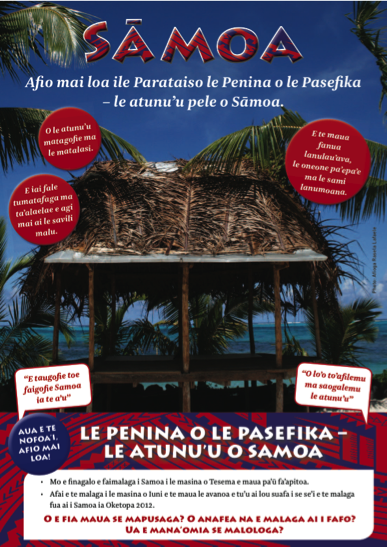Gagana Sāmoa L6: Example 3
Example 3: Promotional poster

Gagana Sāmoa
[pdf of larger poster to come]
Context and text type
A poster advertising the attractions of Sāmoa.
Text type
Visual/written, persuasive. Receptive.
TOP
Observations a students might make concerning:
Information, ideas, and opinions communicated in the text
Advertising conventions, for example, the use of words and phrases that have particular associations, are used to evoke a response in the reader:
- le Penina o le Pasefika; I ‘ila; Lanumoana; Ta ‘alaelae.
Imperatives are used for their persuasive power:
- Afio mai loa ile Parataiso.
A compound sentence structure communicates an idea:
- O lo ‘o to ‘afilemu ma saogalemu le atunu ‘u.
The visual information in the poster is carefully chosen to appeal to people in New Zealand wanting a holiday destination. For example, the photo shows blue skies, blue sea, coconut palms, and indigenous housing (fale). These latter two items add an exotic dimension and promote the idea that, by going to Sāmoa, the reader will escape their everyday existence and enjoy a real holiday.
How the designer expresses personal ideas and opinions
The designer has used a photo that contains features that are likely to prove attractive to potential visitors: blue skies, coconut palms, local-style building, etc. As the 'fale' and the coconut palms are not typical of New Zealand, they help create a sense of the 'exotic' in viewers’ minds.
The poster promotes a view of Sāmoa that some might consider romanticised or stereotypical:
- E taugofie toe faigofie Sāmoa ia te a ‘u.
The poster uses descriptive words to express a positive view of Sāmoa:
- O le atunu ‘u matagofie ma le matalasi.
The designer picks up on romantic notions about Sāmoa that people may have acquired from other advertising:
- “O lo ‘o to ‘afilemu ma saogalemu le atunu ‘u”.
How the designer communicates appropriately in the situation
The designer uses respectful terms to acknowledge and communicate with readers, for example, 'Afio mai loa'.
The designer uses visual material to suggest an open, free, and relaxed environment. Similar visual material is often found in advertisements for tourist destinations.
The designer uses typical advertising speak in both captions and text to entice holidaymakers:
- Taugofie, Faigofie, Parataiso.
How the language in the text is organised for the writer’s purpose
The poster is a written and visual text designed to convince potential tourists to make Sāmoa their holiday destination.
The following features are used in the poster and are common to this genre:
- A combination of written and visual elements that work together to present a more convincing case than they could do separately. The placement of words on the photo creates powerful associations in the minds of viewers/readers, which they link to whatever knowledge they already have of Sāmoa and the Pacific (whether from direct or indirect experience) and construct meaning.
- The written text uses metaphors; a common feature of advertising:
- Penina o le Pasefika; Parataiso; To ‘afilemu.
- Emotive language deliberately arouses feelings in the viewer/reader:
- Matalasi, Matagofie, Lanulau ‘ava.
- Rhetorical questions invite a response:
- O e fia maua se mapusaga? O anafea na e malaga ai i fafo? Ua e mana ‘omia se malologa?
- Quotes from other travellers. For example:
- “O lo ‘o to ‘afilemu ma saogalemu le atunu ‘u”) are used to suggest that you, too, will have a great experience of Sāmoa.
- Repetition emphasises the message; for example, Le Penina o le Pasefika appears as a major caption and twice elsewhere.
- Stand-alone phrases catch the eye of the reader and encourage them to read the subtext.
- Readers do not read a poster in the same way as they read a written text (in linear fashion, from left to right). Instead, they tend to go first to the high-impact elements and then gather information from the other visual and text elements in any order. The photo and the various types of written text (captions, quotes, questions, sentences, phrases, metaphors) offer the viewer/reader different entry points.
TOP
Opportunities for developing intercultural communicative competence
Investigate metaphors associated with Sāmoa, New Zealand (for example, Aotearoa, 'land of the long, white cloud'), and other countries.
Compare and contrast brochures advertising New Zealand and and Sāmoa. Consider the purposes of these brochures, the target audience, why certain features are highlighted, and the kinds of language used. Would the inhabitants describe their own country in such terms? Students could prepare posters in gagana Sāmoa advertising the attractions of New Zealand.
Last updated January 16, 2013
TOP


